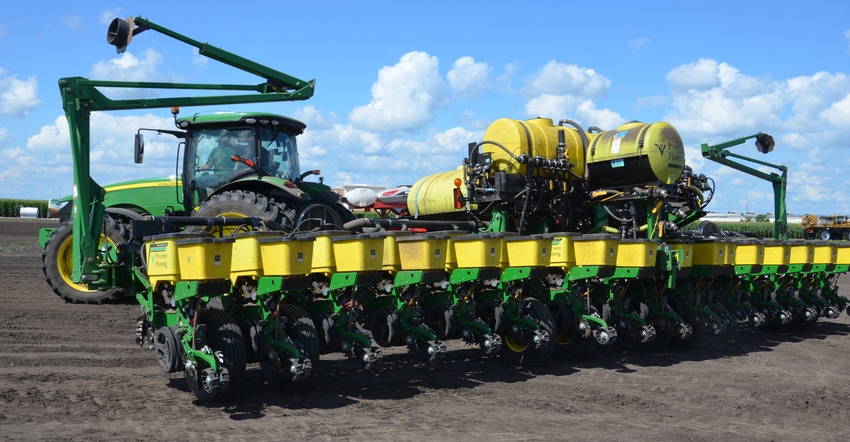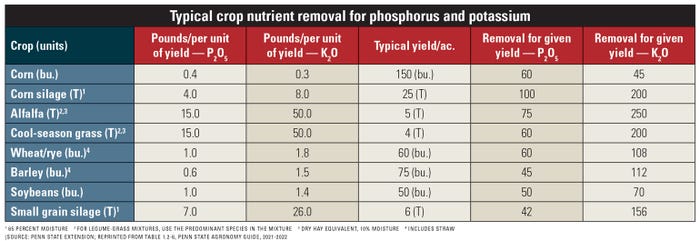March 14, 2022

Given high fertilizer prices, your approach to fertilizer application rates this year may be different than in past years. Double-checking soil test reports from your most recent soil sampling can help you make final adjustments to your fertilizer application rates that may help you reduce costs.
If you haven’t had a soil test done within the past three years, or if you have not been following the fertilizer recommendations from recent soil tests, you should strongly consider collecting new soil samples as soon as possible.
Here are five tips to maximize fertilizer usage and possibly reduce your costs:
1. Lime if necessary. The first soil fertility parameter is to check soil pH, because it controls many aspects of nutrient availability and crop health.
Correcting soil pH with lime is also relatively inexpensive when you consider liming will provide benefits over several years of crop production. The optimum range of soil pH for most agronomic crops is 6.0 to 6.5, but for barley and alfalfa, it is 6.5 to 7.0. If your soil pH falls below these optimum ranges, follow the limestone application recommendation on the soil test report.
Limestone takes up to six months to fully react in the soil and neutralize acidity, so planning ahead is important, especially for sensitive crops such as alfalfa and barley.
2. Check P and K levels. Potassium levels in the soil can draw down faster than other nutrients because of potentially heavy withdrawals by forage crops, or harvesting of straw and fodder. However, many fields that are regularly manured receive plentiful potassium and may have above-optimum potassium levels.
The optimum range of Mehlich 3 extractable potassium is 100 parts per million to 150 ppm K for grain crops, and 100 ppm to 200 ppm K for forage crops. Note that some labs report potassium levels in units of pounds per acre or K2O, in which case you need to convert the reported nutrient levels back to a ppm-K basis.
After checking the potassium levels, check the Mehlich 3 extractable phosphorus level. The optimum range of phosphorus for agronomic crops is 30 ppm to 50 ppm P. Similar to potassium, some labs may report phosphorus levels in units of pounds per acre or P2O5, which will require a conversion to units of ppm P.
If your P or K levels are in the optimum or above-optimum range, there is no need to apply that nutrient this year. This is a departure from our normal "build and maintain" philosophy of managing nutrients where we recommend maintenance applications of P and K to replace crop removals when soil test levels are in the optimum range.
However, soils that have P or K levels in the optimum range have enough of that nutrient to grow a crop without yield losses for at least one year and possibly multiple years.
Therefore, while fertilizer prices are high, I recommend not fertilizing when soil test levels are in the optimum range.
3. Know when to fertilize. If you have soil test levels for P or K that are below the optimum range, then applications are warranted because of the increased likelihood of yield declines due to nutrient deficiencies.
Our normal recommendation of "build and maintain" calls for an addition of fertilizer designed to raise the soil nutrient level up to the optimum level (the build component), plus an addition to replace crop removal (the maintain component).
Following the "build and maintain" approach is good when fertilizer prices are relatively inexpensive. It is a good investment to build up the store of soil nutrients to meet the needs of your crops. Raising nutrient levels to the optimum range puts you in a good position to forego nutrient applications in years when the fertilizer market experiences price shocks.
However, it is not the right time to invest in soil nutrient building when fertilizer prices are as high as they are today. Right now, it is more profitable in the short term to apply just enough nutrients to meet your crop needs. In other words, don't invest in buildup this year.
For fields with soil test levels in the below-optimum range, I suggest P and K fertilizer application rates be calculated to meet crop removal rates. Crop removal rates for P2O5 and K2O can be calculated based on the expected crop yield, multiplied by the removal rate for each unit of crop yield from the table below:

4. Adjust application methods. Consider application methods and nutrient sources that can help increase efficiency and reduce costs.
For P fertilizers, the application should be banded rather than broadcasted to reduce fixation by soil minerals, and be placed several inches deep into the soil so that crop roots can access the nutrients. Applying MAP (11-52-0) or ammonium polyphosphate (10-34-0) fertilizer with granular or liquid starter fertilizer units on a planter is a perfect strategy to increase P efficiency.
When using DAP (18-46-0) fertilizer, the band should be placed further from the seed — more than 3 inches — or be applied several weeks before planting to reduce ammonia toxicity on emerging seedling roots.
Potassium, which easily diffuses through the soil, can be broadcast on the soil surface. Because muriate of potash fertilizer has a high salt index and can injure young seedlings, the application rate in a starter band should be limited. For field corn, the rate of N, plus K2O in the starter, should be limited to 70 pounds per acre if the band is placed about 2 inches from the seed.
5. Consider using manure. Manure is a valuable source of N, P and K. It is abundantly available in some parts of Pennsylvania, New York and other places. Efforts should be made to maximize the efficiency of the nutrients in manure to reduce the amount of supplemental fertilizer needed to meet crop needs.
To increase the efficiency of manure N, consider injecting liquid manure to reduce volatilization. Alternatively, volatilization can be reduced by applying liquid or solid manures when air temperatures are cold — less than 40 degrees F. Late-winter and early-spring (mid-March) application can provide a good balance between realizing cold temperatures at the time of application and mitigating nutrient losses that can occur during winter.
To reduce the risk of nutrient runoff, avoid spreading manure on fields with steep slopes, high erosion rates, poorly drained soils or in fields that are close to water. Manure applications should also be prioritized on fields that require N, P and K to maximize utilization of all three nutrients. If your soil tests are already optimum or above-optimum in P and K, consider exporting some of your manure to neighboring farms that need those nutrients.
White is an assistant professor of soil fertility and nutrient management at Penn State.
Source: Penn State Cooperative Extension, which is solely responsible for the information provided and is wholly owned by the source. Informa Business Media and all its subsidiaries are not responsible for any of the content contained in this information asset.
You May Also Like




